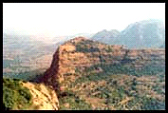Environmental
Pune - a beautiful city, began as a tiny agricultural settlement in the 8th century. It was located amidst forested hills and rivers including two main rivers - the Mula and the Mutha.
When the British captured it by defeating the Marathas in 1818, the city was hardly 5 sq kms. The Pune urban area is now 140 times the original area, and is a metropolis covering more than 700 sq kms. area, consisting of the Pune and Pimpri Chinchwad Municipal Corporations and the Pune, Khadki and Dehu Road Cantonments.

The Beauty...
Pune lies at the edge of the Deccan Plateau. Its location within the Sahyadri range of the Western Ghats lends it an undulating landscape, generous rivers and a rich diversity of plant and animal life. The Pawna and the Indrayani traverse the north - western edges of the urban area and the Sinhagad-Katraj-Dive Ghat range forms the southern boundary of the urban area. Pune also has the confluence of the Mula and Mutha, near the Sangam bridge. The highest point within the city is the Vetal Tekdi (800 m). The highest point of the urban area is Sinhagad (1400m).
And the Beast within...
In the past two decades, the land use pattern in Pune has changed considerably - urban sprawl has occurred at the cost of wooded areas, agricultural land and grassland scrub habitats.
A series of studies on the biodiversity of various areas in the city have been done by RANWA. These have been published in the Journal of Ecological Society. The studies show that while the diversity of fungi, herbs and trees seems to be as much or more in the areas impacted by human activity, the diversity of fish and birds is lower in the impacted areas.
While the green cover in Pune is perhaps one of the best compared to other Indian cities, most of the tree species are exotic and ornamental. While these do certainly look beautiful and colourful, the increase in ornamental species has often been at the cost of local tree species, including fruit trees like mango, jackfruit, jamun, guava, banyan, peepul and neem. Mango and guava were common in orchards along the fringes of the city, but such areas are now residential colonies. The banyans were common as avenue and habitation trees earlier, but are no longer planted and in fact are being chopped down to make way for buildings and widening roads. The loss of large, old trees has affected the tree nesting bird species, like the hornbills. It is not just the cultural heritage of Pune that is lost when old bungalows and buildings are pulled down - it also triggers loss of animals such as bats and civet cats.

Need for conservation
The natural areas in Pune, though highly impacted are still its greatest assets. The hills, lakes, rivers and tanks, and wooded areas are not just beautiful or places for recreation - they act as the lungs of the city, absorbing noise, and tempering the heat of summer. They are also sinks for air and water pollution.
The need to conserve and protect these natural assets is the greater now, as the city grapples with increasing inmigration, and the inability of the urban governance systems to keep pace with the demand for infrastructure for fulfilling basic needs and civic amenities. This is especially manifest in the overcrowded roads, lack of a good public transport system, parking spaces, and consequently very high levels of air pollution.
The apathy
Pune can also be termed an irresponsible city, in that it has not been able to ensure appropriate water quality in its rivers. Not only does the sewage and industrial waste lead to problems within the city, but also downstream. Within the city, the polluted rivers sustain a carpet of hyacinth leading to acute mosquito problems. Pune itself gets its water supply from the upstream dams, but manages to pollute the diminished and dammed rivers as they pass through, seriously affecting the quality of life in the villages downstream that directly depend on them.
The challenge
Both the Pune and the Pimpri Chinchwad Municipal Corporations have been producing their annual Environmental Status Reports as required by law, where these problems are reflected. The Municipal Corporations and the Cantonment Boards have also made some efforts to be more responsive in governance and to tackle issues such as solid and hospital waste, and creation of green spaces. Pune also has a large number of very active citizens groups, and some of the best brains in the country in the government, in academics, in industry and among NGOs.
But, is it public awareness and public pressure that is lacking, or is it political will ? When it comes to cleaning up our act, we haven't quite got our act together.
There is hope...
Take any local environmental issue, and you are sure to find some people in Pune who have thought through the issue and developed solutions. Model programmes from all over the country are also available. The challenge is to scale these up for the whole city.
Pune INTACH aims to develop and promote legislation that protects the natural heritage of the area in such a way that it complements the city and yet allows development. Towards this, we plan to work jointly with other local NGO's.
We invite you to help us carry through this enormous task of safeguarding the environs of this city and beyond.





